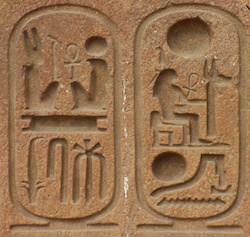Names were chosen with care to represent an individual’s personality, their devotion to a particular god or location, or to reflect the times in which they lived. The simplest names were nouns or adjectives, such as Neferet (“beautiful woman”), User (“strong”), or Nedjem (“Sweet”). Others took the form of statements such as Ptahhotep, (“Ptah is satisfied”), Tutankhamun (“the living image of Amun”), or Hatshepsut (“foremost of noble ladies”). Some names ran in the family (Djau, a sixth dynasty vizier, had at least five brothers who shared his name).

It was common to apply an epithet to help distinguish people with the same name, such as Aa (“great” or eldest), Hery-ib (the one in the middle), and Nedjes (“small” or youngest). Similarly, people often included the name of their father (the epithet Ir-en meant “of his body”) or mother (the epithet Mes-en meant “born of”).
Nicknames and abbreviations were also common in ancient Egypt. “Meryamun”, “Merypath”, and “Meryneith” were all abbreviated to “Mery” while “Nefertiti” was often shortened to Tiy. Nicknames such as Tahemet (“Queenie”) were common while others (such as “Kyky” meaning monkey) seem to have been very personal. Ramesses’ troops called him by the nickname Sese, “the vanquisher”.
The Egyptians believed that if you knew something’s name, you had power over it. If you wrote the name of a dangerous animal or evil spirit on pottery and smashed it you were symbolically killing the evil. So called “execration texts” have been discovered all over Egypt particularly near burial areas. According to one myth all Egyptians were given a secret name at birth by the goddess Renenutet which was never disclosed to protect them from harm.

A person’s name could be changed under certain circumstances. For example, Seti (“man of Seth”) changed his name to “man of Osiris” in his temple to that god to avoid causing offence (as Osiris was murdered by Set). An excerpt from a New Kingdom trial names the accused as Mesedsure (“Re hates him”), Bim-em-Wase (“evil in Thebes”), and Pa-neck (“the serpent”). Clearly these were not their birth names; their names were corrupted because they were accused of a terrible crime, attempting to murder the Pharaoh Ramesses III. The king’s son was also involved in the plot, and was re-named Pentware (“the fugitive”) suggesting that he left Egypt to avoid being charged with attempted patricide.
The pharaohs of Ancient Egypt did not restrict themselves to simple names. Most pharaohs are known to us by their birth names but the kings lists use their throne names. For example, Ramesses the Great’s birth name was Ra-messes Mery-Amun (“born of Re, beloved of Amun”), but the kings lists record his throne name User-Maat-Re Setep-en-Re (“the justice/truth of Re is powerful, Chosen by Re”).

Until the Fourth Dynasty, pharaohs only really used one name, but by the Middle Kingdom they had five including the Nebty (Two Ladies) name, the Golden Horus Name, a Prenomen and Nomen (written in the cartouche), and a birth name (written in a serekh).
Bibliography
- Allen, James P. (2010) Middle Egyptian
- Collier, Mark and Manley, Bill (1998) How To Read Egyptian Hieroglyphs
- Rice, Michael (1999) Who’s Who in Ancient Egypt
- Wilkinson, Richard H. (2003) The Complete Gods and Goddesses of Ancient Egypt
Copyright J Hill 2016